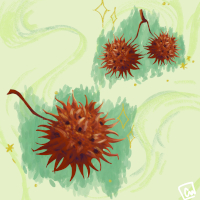One afternoon at the wig shop, a bird-like woman enters, a gauzy lavender scarf wrapped around her bald head, the cloth flecked with silver. She is pale and thin, the chemotherapy making her wilt. Her clothes hang loosely from her body.
The wig-shop owner, a stout woman with a formidable chest, speaks to the bird-like woman in a gentle voice, pointing to a curly blond wig and then a wavy black one and then a straight red bob she says would go nicely with the bird-like woman’s hazel eyes. The woman nods even though she is not a redhead.
Yes, that one, she says. Let’s try that one. Only . . . The woman looks around. No one is in the shop but her and the owner and the mannequins. The walls are lined with mirrored glass, the mannequins’ heads reflecting back at her from all angles. She studies them for a moment, their staring faces. At the front of the shop are two large windows that face onto the sidewalk, allowing anyone to look in. Do you have somewhere more private?
Of course, honey, the owner says. She takes the woman to the back room, which is cluttered with cardboard boxes and broken display tables. There’s one mirror, leaning against some half-filled shelves, in a large gilded frame.
The owner lingers, as if she is reluctant to leave the bird-like woman alone, but the woman says, Thank you, her voice firm. Her voice is still firm, even if her body is frail. She waits until the owner has closed the door, and then she steps in front of the mirror and takes a long look.
When she is feeling more upbeat, she tries to make a joke of her appearance, telling her husband that she looks like a baby dinosaur, freshly hatched. He tells her of course she doesn’t, that she looks beautiful, but she prefers the baby dinosaur to beautiful. Beautiful is what you tell a person who has no hair, who has only scars where her breasts used to be.
Something in the mirror catches her eye. The corners are streaked with grime and dust, but behind the smudges she thinks she sees a face. She feels her heart speed up as she turns, but it is just another mannequin head sitting on the shelf. The nose has broken off. It has no wig.
You and me, she says to the head.
She looks back to the mirror and begins the slow process of unwinding her scarf, wrapping the folds of fabric around her hand as she goes, revealing her bare skull inch by inch. She places the scarf on one of the few empty surfaces and picks up the red wig. She is lifting it to her head when she hears a voice behind her.
No, don’t.
Her heart speeds up again, and she turns to the door, but it is still closed. She looks around the room, but everything is as it was: the haphazard stacks of boxes, the dusty beam of sunlight, the stray mannequin head, tilted slightly askew. She turns back to the mirror, her fingers looping through the smooth netting on the underside of the wig as she again raises it to her scalp.
Please, the voice says, leave it off.
This time, the woman whirls around too fast, the dim room swirling for a moment before it steadies. Still, there is no body, no movement.
The woman scans the room again, more slowly now. The plastic head sits on the same place on the shelf, but its eyes seem to have shifted slightly. She turns back to the mirror.
Please, she hears the voice again, I’ve never seen anyone who looked like me before.
Let me see your body, it says.
The woman hesitates, looking away from the face.
Show me what you look like, the mannequin says, insistent. I want to see.
The woman pauses for a long moment. Over the past several months, so many people have seen her naked body—the doctors, the nurses, the lab techs—but to them, it is only one misbehaving body out of many misbehaving bodies, the casing for a problem to be solved. They treat her as if she is an anatomical model, one of their classroom dummies. They mark up her flesh with dotted lines: cut here.
Her husband sees her body, too, of course: when she is changing, the few times they’ve been able to make love. When her shoulder hurts, he helps her in the bath, but he looks away when it is time to soap her chest. He acts like he is not looking away, but she can tell that he is, can feel him flinch as the sponge meets her sternum.
She wishes her husband would talk to her like this voice, this voice that wants so badly to see her naked form. She wishes her husband would grab her, like he did in the old days and kiss her all over, his lips on her flesh, on places that no other lips had ever touched: her hip, her butt cheek, behind her knee.
Now, he is afraid that if he kisses those places, he will break them, that if he touches her, she will shatter.
She looks again at the mannequin’s face in the mirror then nods and puts down the wig. She unbuttons her shirt, sloughing it off her bony shoulders and letting it drop to the ground. Her chest is covered by a cream cotton bra, no wires, the kind she remembers begging her mother to buy her when she was eleven and her breasts were only starting to come in.
Keep going, the voice says. Please.
She reaches around her back and unclips the clasp. She closes her eyes and lets the bra too fall to the floor. She cannot look at what her chest has become, at the X’d-out scars across what used to be her nipples, the concavity of her solar plexus, the neat stacking of her protruding ribs. She feels a phantom pain in her breasts, the breasts that no longer exist, and she wonders if the mannequin feels this same pain in the body it has never had.
When she finally opens her eyes, she does not look at her body, at the reflection of the body that is her body but is not her body, but instead at the face in the mirror. It is watching her intently, its eyes wide.
I wish I could know what it is to have a body, says the voice.
The woman hesitates. She turns. She walks to the shelf where the mannequin’s head sits immobile.
Go ahead, it says.
The woman picks up the mannequin’s head, the plastic smooth and cool on her palm. She is careful not to touch the mannequin’s face—not to stick a finger in its nose or eye. She holds it gently by the base of its neck, where the plastic flattens out, waiting for a body to support it.
She walks back to the mirror. She faces the glass and lifts the mannequin’s head in front of her own. The woman cannot see the image in the mirror; the mannequin’s head blocks her view.
Describe it to me, the woman says. Tell me what you see.
It’s what I’ve always wanted, says the voice. A body of my own.
There is a noise out in the hallway, a clattering of objects. The woman freezes. But the noise subsides.
All right, the woman says. Time to put you back.
But, when she tries to lower the head, her hands feel only her own cheeks, her own chin. She tugs harder, but still the mannequin’s head will not budge. She twists her torso to look at the mirror from a different angle, but still she cannot see her face. She sees only the face of the mannequin, its broken nose, looking strangely at home on her body. Is the mannequin’s face now her face? Somehow, this thought doesn’t induce any panic, only a strange wave of relief.
Isn’t this what you want? the mannequin says. If you give me your body, you will always be safe.
The woman thinks about the look on her husband’s face when he accidentally catches sight of her scars.
It won’t hurt, the mannequin says. Not at all. You’ve been through so much pain, I know. This will not be anything like that.
She feels her body beginning to stiffen. She can no longer move her arms, no longer move her feet. The voice speaks soothingly to her, and she does not feel scared. She feels the same way she felt in the seconds after the anesthesia entered her veins, before everything became black.
She could stay here forever. No more pills, no more tubes. A body, permanent, unchanging.
The woman hears a knock on the door. She feels a sudden pain at her neck, like the pins and needles when your foot falls asleep but amplified by a thousand. The pain sears through her, soaring through her fragile body. She has grown so accustomed to pain. It does not shock her; it only wakes her. Wakes her to this body that is still her body, this body that she is not ready to give up on, not yet.
With one great tug, the woman pulls the mannequin’s head away. The voice is quiet as she puts the head back on the shelf, its eyes unblinking.
One second! she calls, slipping her shirt back over her head, smoothing it across her breastbone.
She hurries past the wig-shop owner, thanking her for her time, no wig today.
Tonight, she will pour an entire bottle of bubble bath into the tub.
She will lower her body into the eucalyptus heat.
And when her husband tries to look away, she will hold his face, gently, by the chin.
She will take his hand and press it to her chest.
This is a sequel to the story, "At Night in the Wig Shop," which was published on Booth in 2014.



